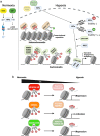Gene regulation by histone-modifying enzymes under hypoxic conditions: a focus on histone methylation and acetylation
- PMID: 35869366
- PMCID: PMC9355978
- DOI: 10.1038/s12276-022-00812-1
Gene regulation by histone-modifying enzymes under hypoxic conditions: a focus on histone methylation and acetylation
Abstract
Oxygen, which is necessary for sustaining energy metabolism, is consumed in many biochemical reactions in eukaryotes. When the oxygen supply is insufficient for maintaining multiple homeostatic states at the cellular level, cells are subjected to hypoxic stress. Hypoxia induces adaptive cellular responses mainly through hypoxia-inducible factors (HIFs), which are stabilized and modulate the transcription of various hypoxia-related genes. In addition, many epigenetic regulators, such as DNA methylation, histone modification, histone variants, and adenosine triphosphate-dependent chromatin remodeling factors, play key roles in gene expression. In particular, hypoxic stress influences the activity and gene expression of histone-modifying enzymes, which controls the posttranslational modification of HIFs and histones. This review covers how histone methylation and histone acetylation enzymes modify histone and nonhistone proteins under hypoxic conditions and surveys the impact of epigenetic modifications on gene expression. In addition, future directions in this area are discussed.
© 2022. The Author(s).
Conflict of interest statement
The authors declare no competing interests.
Figures

Similar articles
-
Hypoxia mimetic deferoxamine influences the expression of histone acetylation- and DNA methylation-associated genes in osteoblasts.Connect Tissue Res. 2015 Jun;56(3):228-35. doi: 10.3109/03008207.2015.1017573. Epub 2015 Mar 16. Connect Tissue Res. 2015. PMID: 25674819
-
Pathophysiological response to hypoxia - from the molecular mechanisms of malady to drug discovery: epigenetic regulation of the hypoxic response via hypoxia-inducible factor and histone modifying enzymes.J Pharmacol Sci. 2011;115(4):453-8. doi: 10.1254/jphs.10r19fm. Epub 2011 Mar 16. J Pharmacol Sci. 2011. PMID: 21422728 Review.
-
Histone modifications in development.Development. 2025 Jun 15;152(12):dev204384. doi: 10.1242/dev.204384. Epub 2025 Jun 13. Development. 2025. PMID: 40514762 Review.
-
Linking epigenetics to lipid metabolism: focus on histone deacetylases.Mol Membr Biol. 2012 Nov;29(7):257-66. doi: 10.3109/09687688.2012.729094. Epub 2012 Oct 24. Mol Membr Biol. 2012. PMID: 23095054 Review.
-
Epigenetic regulation by histone methylation and histone variants.Mol Endocrinol. 2005 Mar;19(3):563-73. doi: 10.1210/me.2004-0496. Epub 2005 Jan 27. Mol Endocrinol. 2005. PMID: 15677708 Review.
Cited by
-
LncRNA MIR31HG fosters stemness malignant features of non-small cell lung cancer via H3K4me1- and H3K27Ace-mediated GLI2 expression.Oncogene. 2024 May;43(18):1328-1340. doi: 10.1038/s41388-023-02883-4. Epub 2023 Nov 10. Oncogene. 2024. PMID: 37950038 Free PMC article.
-
Chronic hypoxia stabilizes 3βHSD1 via autophagy suppression.Cell Rep. 2024 Jan 23;43(1):113575. doi: 10.1016/j.celrep.2023.113575. Epub 2024 Jan 4. Cell Rep. 2024. PMID: 38181788 Free PMC article.
-
Exploring the causal factor effects of hypothyroidism on ischemic stroke: a two-sample Mendelian randomization study.Front Neurol. 2024 Jan 31;15:1322472. doi: 10.3389/fneur.2024.1322472. eCollection 2024. Front Neurol. 2024. PMID: 38361639 Free PMC article.
-
Hypoxia and aging: molecular mechanisms, diseases, and therapeutic targets.MedComm (2020). 2024 Oct 15;5(11):e786. doi: 10.1002/mco2.786. eCollection 2024 Nov. MedComm (2020). 2024. PMID: 39415849 Free PMC article. Review.
-
Insights into the regulatory role of epigenetics in moyamoya disease: Current advances and future prospectives.Mol Ther Nucleic Acids. 2024 Jul 19;35(3):102281. doi: 10.1016/j.omtn.2024.102281. eCollection 2024 Sep 10. Mol Ther Nucleic Acids. 2024. PMID: 39188306 Free PMC article. Review.
References
Publication types
MeSH terms
Substances
LinkOut - more resources
Full Text Sources

